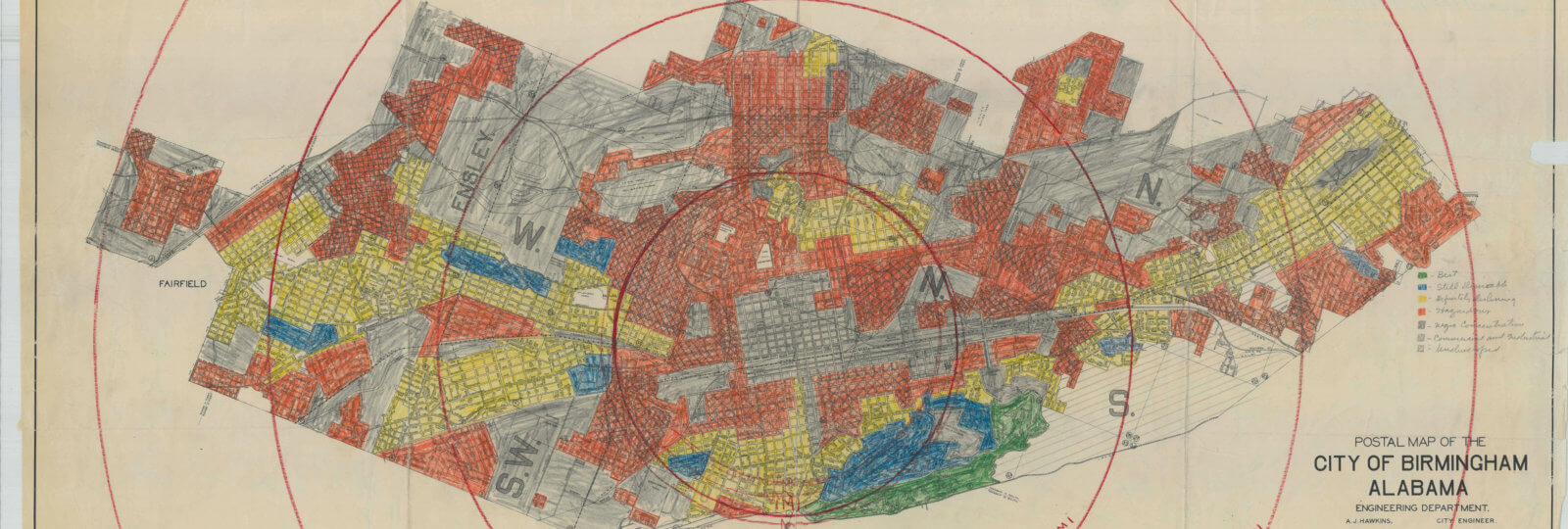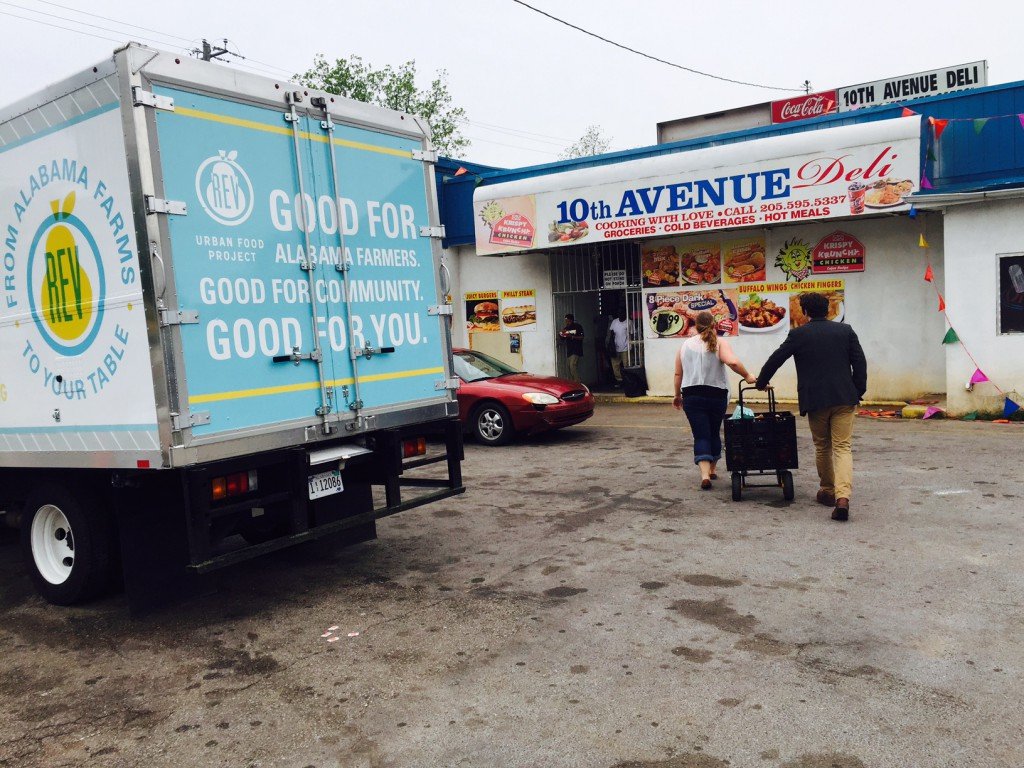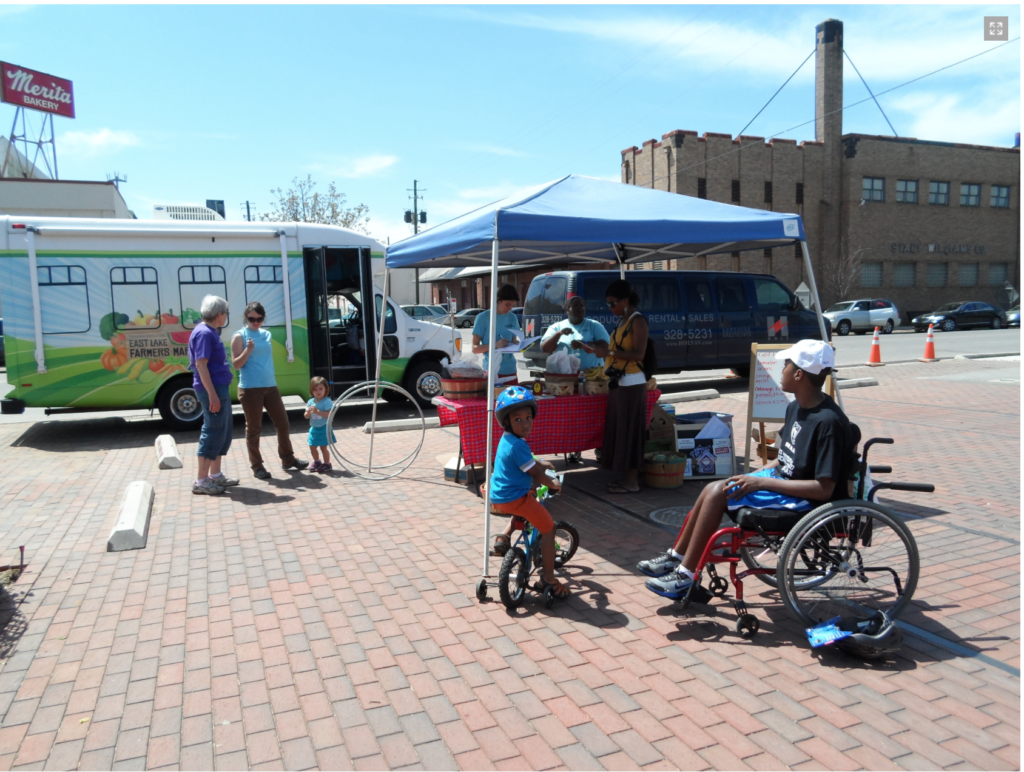

The Fifty One
Birmingham, Alabama, Is Now a Foodie Destination—For Those With Access
Thanks to a nearly 100-year-old redlining map, the chasm between food destinations and food deserts remains. Can grassroots efforts make a difference?
This article was made possible because of the generous support of DAME members. We urgently need your help to keep publishing. Will you contribute just $5 a month to support our journalism?
“As Birmingham goes, so will go your future and the future of your children and your grandchildren.”
—Civil rights activist Anne Braden, 1959
The food of Birmingham, Alabama, is having a moment in the spotlight. In June, TV food personality and chef Andrew Zimmern named Birmingham the “hottest small food city in America right now.” And in May, Birmingham restaurant Highlands Bar & Grill received the James Beard award for most outstanding restaurant in the United States—the same night its longtime pastry chef Dolester Miles took home the award for most outstanding pastry chef.
Then there’s the vast Pepper Place Market, where Birmingham-area residents and people from across central Alabama converge on Saturday mornings to shop for locally grown, freshly harvested food. Rows and rows of white tents are filled with bright-red misshapen tomatoes and plump blueberries sold by the pound. Brochures boast grass-fed cows and chickens raised among the rolling hills of north Alabama. Homemade desserts range in variety from hand-size sweet-potato pies to doughnuts as big as your head.
But not everyone in the city has access to fresh, local food. Several densely populated areas have few healthy options and no full-size grocery stores within miles. According to The Urban Food Project, a program of the economic-redevelopment group REV Birmingham, 88,000 Birmingham residents are living in areas that have been designated “food deserts,” and almost all of the residents are Black or Latino. (The term “food deserts” is defined by the USDA as a community with limited access to healthy food; a growing number of researchers are pushing back against that definition as “a lazy shorthand.”)

A number of initiatives are at work trying to reconcile and address these two facets of 21st-century Birmingham; in addition to traditional food banks and other food insecurity efforts, REV Birmingham is working to build a vision of greater equity as part of its economic development work.
“Corner stores [have] become [a neighborhood’s] grocery stores—and food desert communities are experiencing negative health outcomes as a result,” says Taylor Clark, director of The Urban Food Project. “This community-wide strategy is what it takes to shift the dynamic. It’s important work—because everyone deserves the right to fresh, healthy food. But fully understanding—and improving—the state of food for all in Birmingham requires an understanding of the city itself. While politicians and developers like to project an image dominated by new high-end condominiums, a resurgence of historic high-rises, and a world-class university, in actuality, the city is intensely segregated along historic lines of class and race—like most of the United States. And that history of segregation continues to shape every aspect of city residents’ lives—including the food they have access to.
Birmingham and its neighborhoods and neighboring communities create a color-coded puzzle of opposite extremes. For instance, residents of the neighboring city of Mountain Brook, most of whom are white and wealthy, typically leave their homes to commute eastward into downtown for work; while Black and mostly working-class residents tend to commute to work westward, into service jobs in those wealthier communities. They criss-cross the same crowded highways but rarely intermingle. Their children attend different schools, visit different parks, and run in different circles. The seeds of Birmingham’s present-day segregation were planted generations ago.
Birmingham’s History of Redlining
Today’s Birmingham was largely shaped by the city’s original redlining maps, created in the 1930s with the intent of formalizing the division between white and Black citizens.
“We take that map today and overlay it over the blight and deteriorated communities in our city, and they’re in the exact same places,” John Colon, then-director of the Birmingham’s Department of Community Development, told The Birmingham News in 2015.
The redlining map above effectively divided Birmingham by so-called desirability and race. The categories in the 1930s were labeled “Best, Still Desirable, Definitely Declining, Hazardous, and Negro Concentrations.” Per the map, Black families were funneled into the red zones, near industrial and flood zones, while the thin, green spot at the bottom—which became portions of Mountain Brook—was reserved exclusively for wealthy white families.
Mountain Brook sits atop a mountain overlooking some of Birmingham’s poorest communities. Today, according to IRS data, it contains the state’s second wealthiest Zip code.
In the 1960s, after receiving a go-ahead from federal courts, Black citizens of Birmingham began moving into the white-only neighborhoods of Fountain Heights and North Smithfield in order to break the city’s unlawfully segregated housing patterns. Courageous families began chipping away at the city’s color line, and they were relentlessly terrorized for it, with a wave of bombings and shootings that spanned the 1940s to the 1960s.
How Redlining Shapes Birmingham’s Food System Today
So what does this history have to do with food in 2018? A lot.
As a direct result of the bombings and terror, insurance companies labeled businesses in those areas high-risk; they therefore had trouble acquiring insurance, which in turn meant the racial zoning maps affected not only housing, but also community grocers, restaurants, and other businesses’ ability to operate in those newly integrated communities. Those redlined neighborhoods of the past are the food deserts of today, and the city’s Black and Latino residents are far more likely to live in them.
“Jim Crow laws of the past led to some of the disparities that exist in underrepresented communities, specifically those of color in Jefferson County,” says Gregory Townsend, Health Service Administrator for the Jefferson County Department of Health.
Townsend is a member of the collaborative that created the 2013 Place Matters Report from the Joint Center for Political and Economic Studies that laid out the status of health equity in Jefferson County.
The report highlights racial inequities in Jefferson County such as the infant mortality rate being two-and-a-half times higher for Black mothers than white mothers. And it notes that Black residents within the county are significantly more likely to die of complications from heart disease, cancer, or diabetes than their white counterparts.
“The publication of the report in 2013 was groundbreaking because it gave a clearer picture of long-term racial disparities in Jefferson County,” Townsend says.
While redlining is in no way the only cause of health inequity in Birmingham today, it certainly played a part in creating food deserts by sparking the closing of businesses, including restaurants and grocers, which remain scarce there today.
Created as part of the Place Matters report, the map above overlays data from the USDA Food Access Research Atlas with a map of the racial and ethnic distribution of the county. As it turns out, the 1930s redlining map could have predicted the disparities shown in the map above.
Darrell O’Quinn, Birmingham City Councilman for District 5, which includes Fountain Heights, Smithfield, and other neighborhoods, says that from a financial perspective, redlining decimated these neighborhoods even more than Jim Crow.
“Jim Crow came first and it was a set of overtly racist policies, but then redlining came in behind it and was the sort of covert, institutionalized racism we’re more familiar with today,” says O’Quinn. “Under Jim Crow, people could still at least amass wealth, and you had Black-owned businesses, including local grocers, in many of these communities. Redlining undermined those businesses and almost ensured that desegregation would harm African American communities.”
That lack of capital in redlined neighborhoods catalyzed the food access issues those communities still face today.
Even as the city’s national food scene profile has risen, community groups in Birmingham have also been working to improve access to healthy, fresh food choices for all of the city’s residents. The Urban Food Project, for instance, has launched a Farm to Corner Store Initiative that helps store owners buy, merchandise, and sell fresh and local produce within underserved communities. And many of the farmers that sell food at markets such as Pepper Place and the East Lake Farmers Market have been known to give their extra products to those in need.

The Community Food Bank of Central Alabama is creatively addressing food deserts in Birmingham with The Corner Market, a 24-foot mobile grocery store equipped with freezers of meat, dairy, and fresh produce. Most Wednesdays, The Corner Market serves rural and inner-city communities in and around Birmingham.
“We’re not competing with grocery stores, we’re going to places where there are no full-service grocery stores,” the Community Food Bank’s Director of Partnerships, Elizabeth Wix says. Initially, the food bank went to open a traditional food pantry in the rural outskirts of the city, but according to Wix, residents rejected that idea. “’We don’t need another pantry, we need a store,’” the residents told her. “So we created a grocery store on wheels.”
The most encouraging initiatives, however, are the grassroots efforts rising from within the community itself. In 2016, the Urban Ministry in West End launched a pay-what-you-can eatery called WE Community Café. At WE, a $5 suggested donation covers a single meal, a $10 donation covers food and labor, and a $15 donation covers food, labor, and the cost of another person’s meal. If a patron cannot pay, they might help clear tables or lend a hand in the kitchen. Head chef Ama Shambulia is a graduate of Birmingham’s Culinard culinary arts program; she serves fresh, balanced meals to everyone who walks through the door, whether they can afford them or not.
When another Birmingham resident, Hank Layman, noticed that his neighborhood of Ensley in western Birmingham lacked healthy options, he began planting edible gardens for his neighbors upon request. “I was driving around one day last year and realized that Ensley is a food desert and I am a gardener,” said Layman in a 2017 television interview.
These initiatives are inspiring examples of the community coming together to make positive change. But reversing the generations-long impacts of racist segregation policies will require a bigger push.
In 2018, the Internal Revenue Service, along with city and state officials, designated 23 Birmingham census tracts as Opportunity Zones, flagging those areas’ immediate need for economic investment.
Many, although not all, of those neighborhoods were previously redlined, councilman O’Quinn, told Civil Eats. “In a way, the Opportunity Zones program is sort of the antithesis of redlining.” The program, which O’Quinn describes as “basically a tax shelter for capital gains,” allows people wishing to defer or avoid capital gains tax to park their money in Opportunity Funds, which are then used to invest in communities identified as in need of investment.
“Redlining really prevented investment in a lot of these communities,” he says. “It prevented those communities from creating wealth. In a lot of ways I think the intent of Opportunity Zone legislation is to acknowledge that that was bad and to try to do the opposite.”
Between the start of a county-wide health action partnership in 2006 and now, “there’s been an increased understanding of the root causes of inequities in communities,” says Gregory Townsend of the county public health department. “We’re looking at all the social determinants of health and trying to address them at the root, rather than put a band-aid on them.”
Looking ahead, Townsend sees even greater momentum for change in Birmingham. “Do we still have problems with racism and living in the shadow of Jim Crow? Yes, we still have those issues—but I think people are more willing to talk about them, and address them, than they were 50 or 60 years ago.”
This article was produced in partnership with Civil Eats, a daily news source for critical thought about the American food system, for DAME’s podcast, The Fifty One, which explores what national issues look like for women at the local level. You can view the full episode below, and subscribe to the podcast on iTunes.
Before you go, we hope you’ll consider supporting DAME’s journalism.
Today, just tiny number of corporations and billionaire owners are in control the news we watch and read. That influence shapes our culture and our understanding of the world. But at DAME, we serve as a counterbalance by doing things differently. We’re reader funded, which means our only agenda is to serve our readers. No both sides, no false equivalencies, no billionaire interests. Just our mission to publish the information and reporting that help you navigate the most complex issues we face.
But to keep publishing, stay independent and paywall free for all, we urgently need more support. During our Spring Membership drive, we hope you’ll join the community helping to build a more equitable media landscape with a monthly membership of just $5.00 per month or one-time gift in any amount.
















































































